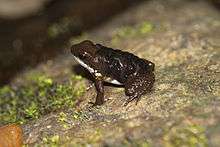Common rocket frog
| Colostethus panamansis | |
|---|---|
 | |
| Scientific classification | |
| Kingdom: | Animalia |
| Phylum: | Chordata |
| Class: | Amphibia |
| Order: | Anura |
| Family: | Dendrobatidae |
| Genus: | Colostethus |
| Species: | C. panamansis |
| Binomial name | |
| Colostethus panamansis (Dunn, 1933) | |
| Synonyms | |
|
Colostethus panamensis (incorrect spelling) | |
Colostethus panamansis, the common rocket frog or Panama poison dart frog is a species of poison dart frog. It is found in northwestern Colombia and Panama.[2] It is one of the best studied poison dart frogs; however, until 2004 Colostethus panamansis was considered a synonym of Colostethus inguinalis, and consequently the older literature uses that name.[3]
Distribution and habitat

The common rocket frog is found in several parts of Panama and in Parque Nacional Natural Los Katios in Colombia. It is found living near streams in forested lowland and hilly country, usually at elevations below 800 metres (2,600 ft).[1]
Biology
Adult males measure 19–27 mm (0.75–1.06 in) in snout–vent length and adult females 25–29 mm (0.98–1.14 in).[3]
The female common rocket frog lays her eggs in clutches among leaf litter. When they hatch, she carries them around on her back for up to nine days when she immerses herself in a fast flowing stream and they become detached and continue their development in the water.[4]
Research
The pathogenic fungus Batrachochytrium dendrobatidis causes the emerging infectious disease chytridiomycosis which is the cause of the decline in many species of tropical amphibian. Colostethus panamansis was used to demonstrate that the fungus was indeed the pathogen responsible for the disease. Healthy rocket frogs from El Copé in Panama were collected and shown to be free of B. dendrobatidis. They were then exposed to an isolate of the fungus. Some of these died and from these B. dendrobatidis was reisolated and was demonstrated to be identical to the original infective agent thus fulfilling Koch's postulates.[5]
Conservation status
The common rocket frog is listed as being of "Least Concern" in the IUCN Red List of Threatened Species. This is because it has a wide range in which it is common, and though the population may be declining, this is not at a rate to allow it to qualify for a higher category. The chief threats it faces are deforestation, logging and farming activities including pollution of streams with pesticides.[1]
References
| Wikimedia Commons has media related to Colostethus panamansis. |
- 1 2 3 Grant, T., Solís, F., Ibáñez, R., Jaramillo, C. & Fuenmayor, Q. (2004). "Colostethus panamansis". IUCN Red List of Threatened Species. Version 2012.1. Retrieved 2012-10-01.
- ↑ Frost, Darrel R. (2014). "Colostethus panamansis (Dunn, 1933)". Amphibian Species of the World: an Online Reference. Version 6.0. American Museum of Natural History. Retrieved 18 January 2014.
- 1 2 Grant, T. (2004). "On the identities of Colostethus inguinalis (Cope, 1868) and C. panamensis (Dunn, 1933), with comments on C. latinasus (Cope, 1863) (Anura: Dendrobatidae)" (PDF). American Museum Novitates 3444: 1–24. doi:10.1206/0003-0082(2004)444<0001:otioci>2.0.co;2.
- ↑ "Rocket frog". Amphibian Rescue and Conservation Project. 2012-05-14. Retrieved 2012-10-01.
- ↑ Karen R. Lips; Forrest Brem; Roberto Brenes; John D. Reeve; Ross A. Alford; Jamie Voyles; Cynthia Carey; Lauren Livo; Allan P. Pessier; James P. Collins (2006). "Emerging infectious disease and the loss of biodiversity in a Neotropical amphibian community". Proceedings of the National Academy of Sciences of the United States of America 103 (9): 3165–3170. doi:10.1073/pnas.0506889103.
